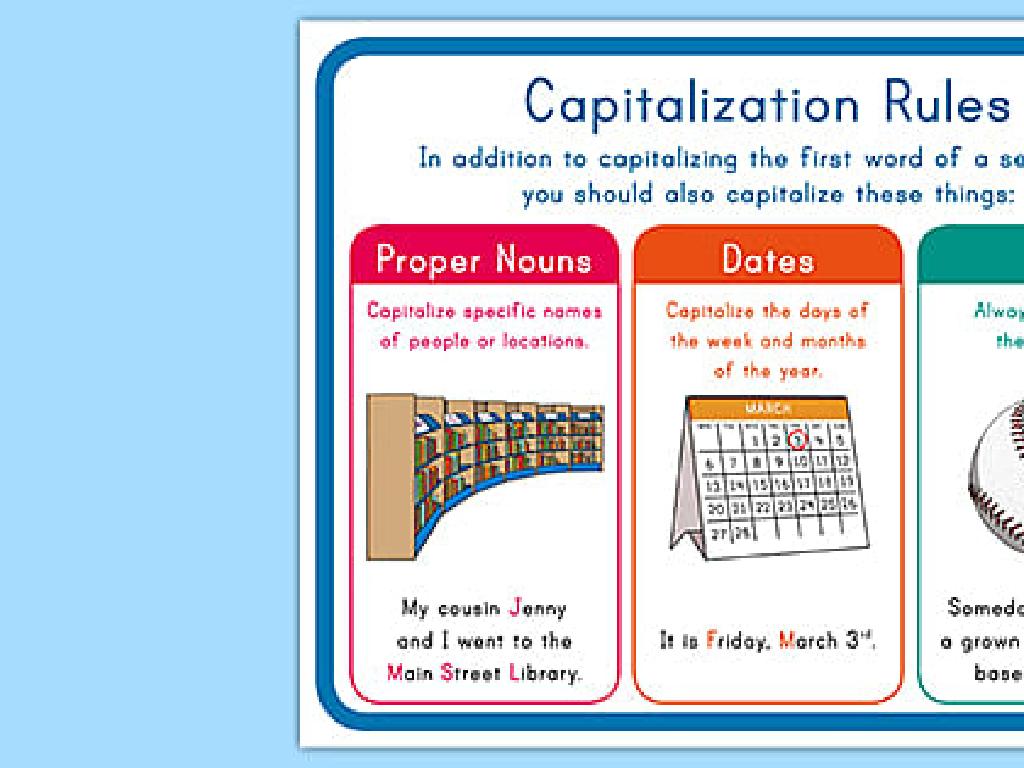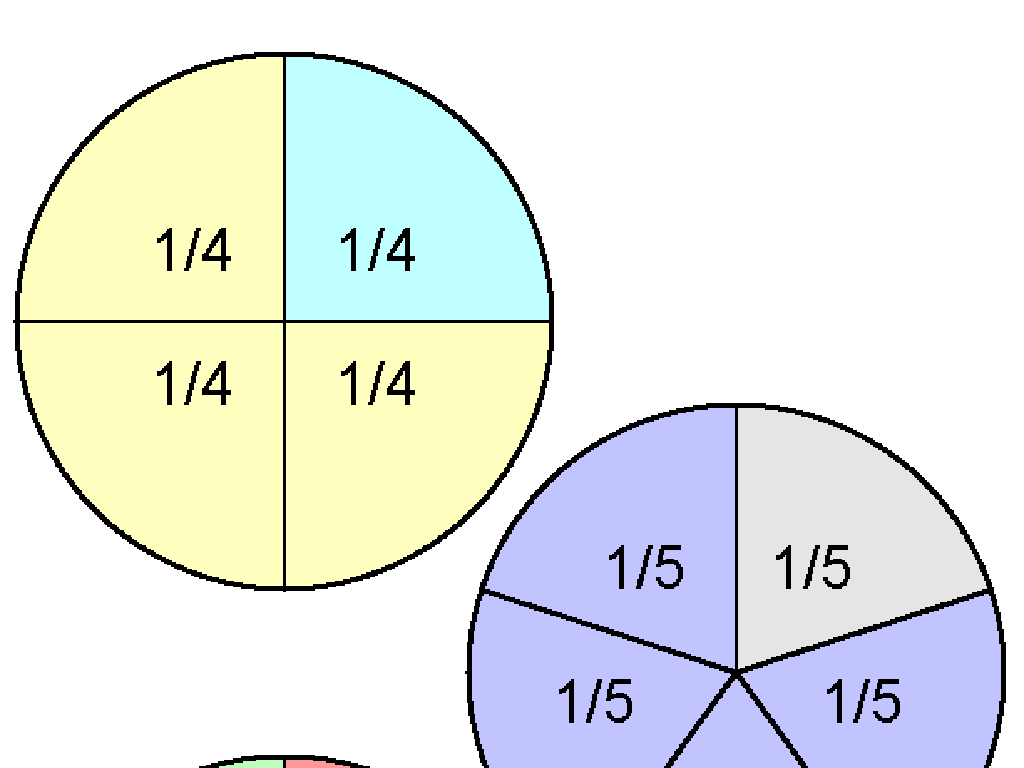Graph And Order Fractions On Number Lines
Subject: Math
Grade: Fourth grade
Topic: Compare And Order Fractions
Please LOG IN to download the presentation. Access is available to registered users only.
View More Content
Welcome to Fractions!
– Learn about fractions today
– Understand parts of a whole
– A fraction represents a part of a whole, like a slice of pizza.
– Daily uses of fractions
– Fractions are everywhere: cooking, dividing pizza, or measuring.
– Practice with number lines
– We’ll use number lines to see how fractions compare in size.
|
Today’s lesson introduces fractions, a fundamental concept in mathematics that represents parts of a whole. It’s important for students to grasp that fractions are not just numbers, but they represent a division of any whole into equal parts. We’ll explore how fractions are applicable in everyday life, such as in recipes or when sharing items equally among friends. To visualize fractions, we’ll use number lines, which will help students understand how different fractions relate to each other in terms of size. Encourage students to think of real-life scenarios where they use fractions. The goal is for students to become comfortable with the idea of fractions and to see their practical value.
Understanding Fractions
– A fraction represents part of a whole
– Like a slice of pizza or a piece of pie
– Consists of a numerator and a denominator
– Top number (numerator) and bottom number (denominator)
– Examples: 1/2 pizza, 3/4 hour
– 1/2 means half of something, 3/4 means three quarters of something
|
This slide introduces the concept of fractions to fourth-grade students. A fraction is a way to represent a part of a whole, which is an essential concept in mathematics and daily life. The numerator, the top part of the fraction, indicates how many parts we have, while the denominator, the bottom part, shows into how many equal parts the whole is divided. Use relatable examples like slices of pizza or segments of time to illustrate fractions in a way that is tangible for the students. Encourage them to think of other examples of fractions they encounter in their daily lives. This foundational understanding will be crucial as they learn to graph and order fractions on number lines.
Understanding Fractions on Number Lines
– What is a number line?
– A straight line with numbers at equal spaces
– Number lines show order and value
– It helps us see which numbers are bigger or smaller
– Comparing fractions using number lines
– Place fractions on the line to see which is larger
– Ordering fractions on a number line
– Arrange fractions from smallest to largest on the line
|
This slide introduces students to the concept of number lines and their use in understanding fractions. Begin by explaining that a number line is a visual representation that helps us see the position of numbers. Emphasize that the spaces between numbers are equal, which is crucial when placing fractions. Show how to compare fractions by placing them on the number line and observing their positions relative to each other. Then, demonstrate how to order a set of fractions by placing them on the number line from the smallest to the largest. Use simple fractions that are easy for fourth graders to understand, and ensure to include examples with different denominators. Encourage students to practice by giving them a set of fractions to place on a number line as a class activity.
Placing Fractions on a Number Line
– Fractions represent parts of a whole
– Numerator: number of parts you have
– If you have 3 out of 4 parts, the numerator is 3
– Denominator: number of equal parts
– If a pizza is cut into 8 slices, the denominator is 8
– Positioning fractions on a line
– Place fractions based on size; e.g., 1/4 is to the left of 3/4
|
This slide introduces the concept of placing fractions on a number line. Begin by explaining that fractions are a way to represent parts of a whole. The numerator, the top number of the fraction, indicates how many parts we are considering, while the denominator, the bottom number, shows into how many equal parts the whole is divided. Emphasize that the value of a fraction is determined by both numbers. Use visual aids to demonstrate how to place fractions on a number line, starting with smaller numerators to the left, progressing to larger ones to the right. Encourage students to practice by placing various fractions on a number line and comparing their positions to understand which fractions are larger or smaller.
Comparing Fractions on a Number Line
– How to compare fractions
– Look at where fractions sit on the number line
– Position determines size
– Fractions right are greater
– Example: 1/2 vs 1/4
– 1/2 is to the right of 1/4, so it’s larger
|
This slide introduces students to the concept of comparing fractions by using a number line. Emphasize that the position of a fraction on the number line is key to understanding its value relative to other fractions. Fractions that appear further to the right are always greater than those to the left. Use the example of 1/2 and 1/4 to visually show this concept. Have students practice by placing various fractions on a number line and comparing them. This will help solidify their understanding of the relative size of fractions and prepare them for ordering fractions.
Ordering Fractions on a Number Line
– What does ordering fractions mean?
– Arranging fractions from the least to the greatest value
– Using a number line to compare
– A number line helps us see the size of different fractions
– Practice with 1/3, 2/3, and 3/3
– Place these fractions on the number line and see the order
– Arrange fractions from smallest to largest
– Practice helps us understand the order of fractions better
|
This slide introduces the concept of ordering fractions, which is a fundamental skill in understanding fractions. Start by explaining that ordering fractions means to arrange them from the smallest to the largest, or the other way around. Use a number line as a visual aid to help students compare the size of different fractions. For practice, use simple fractions like 1/3, 2/3, and 3/3, which also helps to reinforce the concept of equivalent fractions (3/3 is equal to 1). Encourage students to draw their own number lines and place the fractions at the correct points. This activity will help them visualize and understand how fractions can be compared and ordered effectively.
Let’s Practice Together: Placing Fractions
– Practice placing fractions on a line
– I’ll show a fraction; you tell me where
– Closer to 0 means a smaller fraction
– For example, 1/4 is closer to 0 than 3/4
– Let’s find the right spot for each fraction
– We’ll use example fractions and place them correctly
|
This slide is designed for an interactive class activity to help students understand how to graph fractions on a number line. Start by explaining that a number line is a visual representation where numbers are placed in order based on their value. Show them a fraction and ask the class to guide you on where to place it on the number line. Remind them that fractions closer to 0 are smaller. Use clear examples, starting with simple fractions like 1/2, and gradually increase complexity. Encourage participation and provide immediate feedback. For the activity, consider using physical number lines on the board or interactive digital tools if available. Prepare several examples beforehand, and ensure to include a variety of fractions to cover different parts of the number line.
Class Activity: Fraction Number Line
– Receive a worksheet with number lines
– Place fractions on the number lines
– Each fraction goes at its correct spot
– Work in pairs to discuss answers
– Talk about where you placed fractions
– Compare your answers with classmates
– See if your answers are the same or different
|
In this activity, students will apply their understanding of fractions and number lines by placing given fractions in the correct order on a number line. Distribute worksheets with multiple number lines and a set of fractions to each student. Encourage them to think about the size of fractions and where they belong on the number line. Working in pairs allows students to discuss their reasoning and helps them learn from each other. After the activity, facilitate a class discussion to compare answers and address any misconceptions. Possible variations of the activity could include using fractions with different denominators, comparing improper fractions, or even mixing in some decimals for advanced students.
Conclusion & Homework: Fraction Number Lines
– Congrats on mastering fraction graphs!
– Homework: Complete the worksheet
– Finish graphing fractions at home
– Place fractions on number lines
– Use today’s lesson to help you
– Share your work next class
– We’ll review everyone’s work together
|
This slide wraps up the lesson on graphing and ordering fractions on number lines. The homework assignment reinforces today’s learning by asking students to complete a worksheet where they will practice placing fractions on number lines. Remind students to refer to the strategies discussed in class to determine the correct position of each fraction. Encourage them to check their work by comparing fractions to benchmark numbers like 0, 1/2, and 1. In the next class, we will share and discuss the homework to ensure understanding and to celebrate their efforts. Provide a few examples of fractions they might see on the worksheet to get them started.






